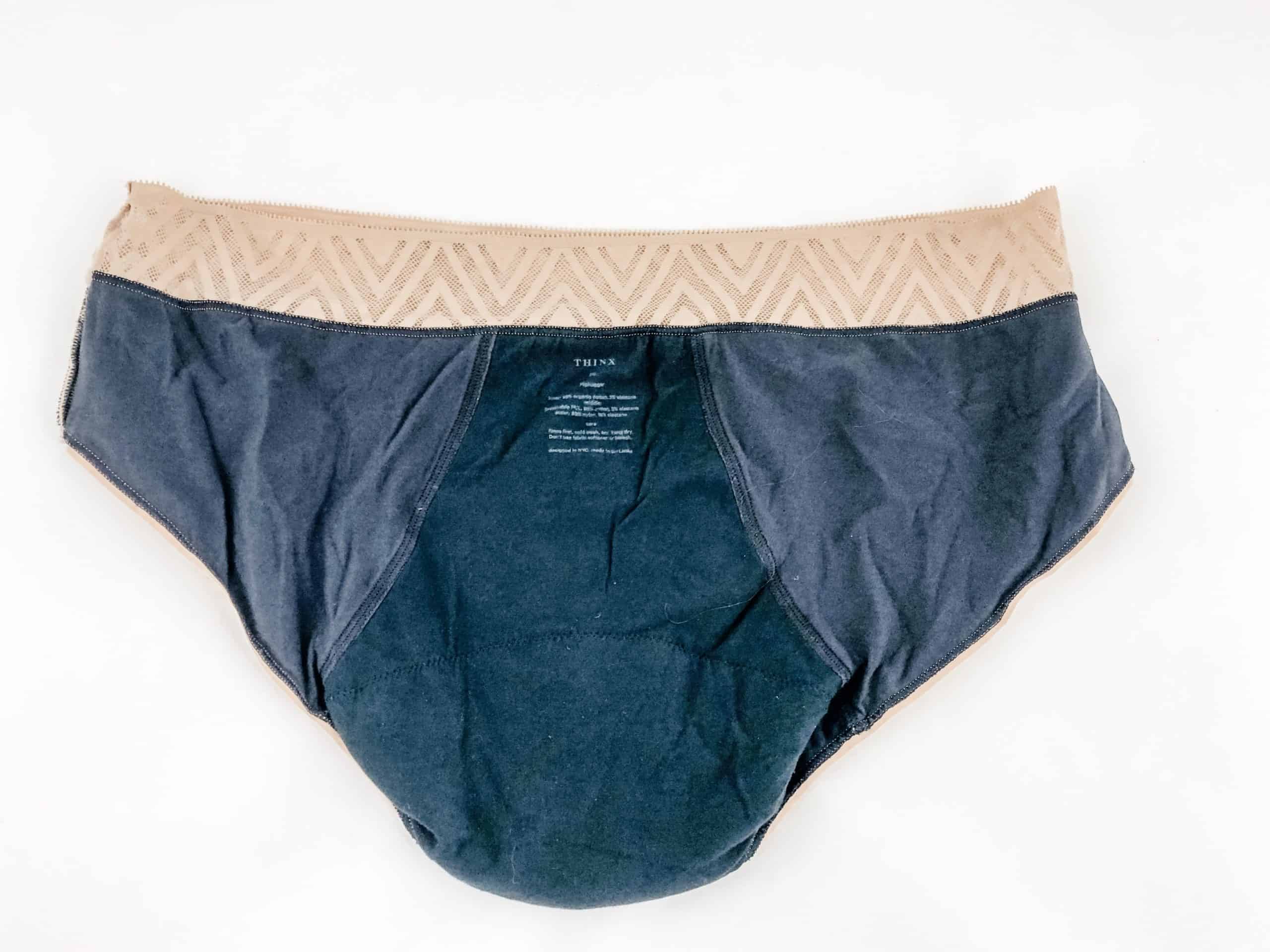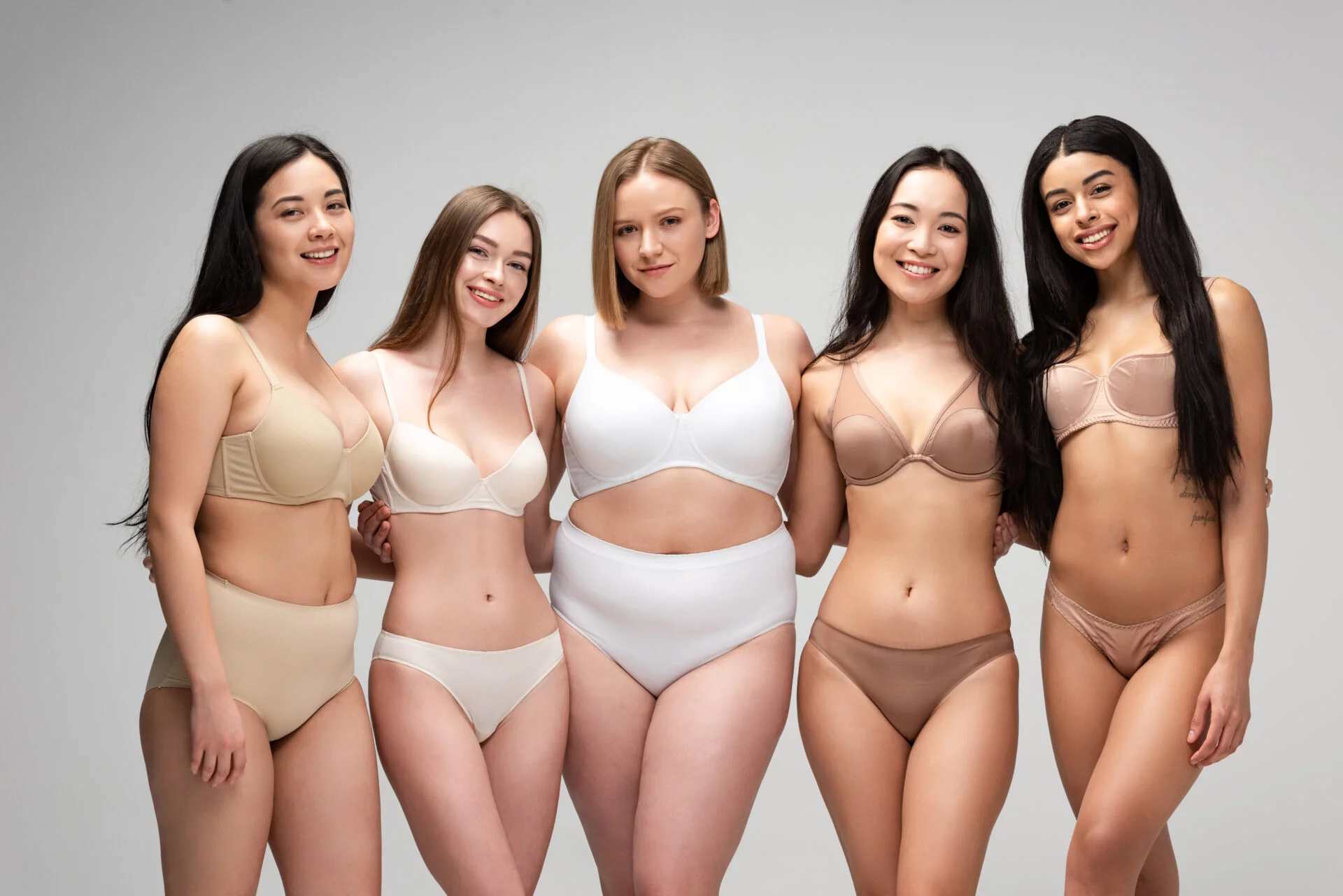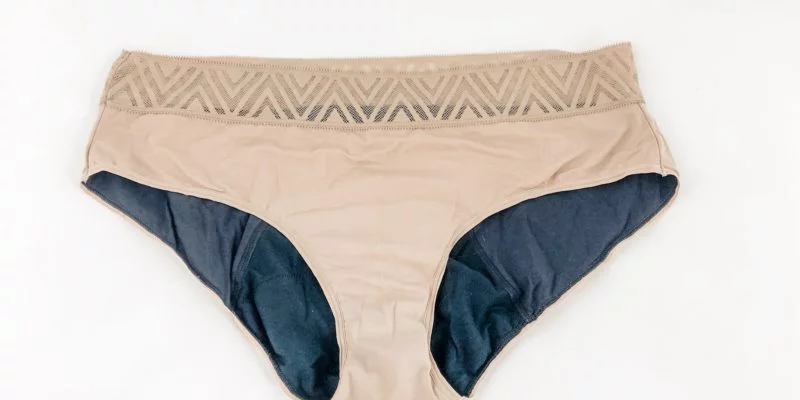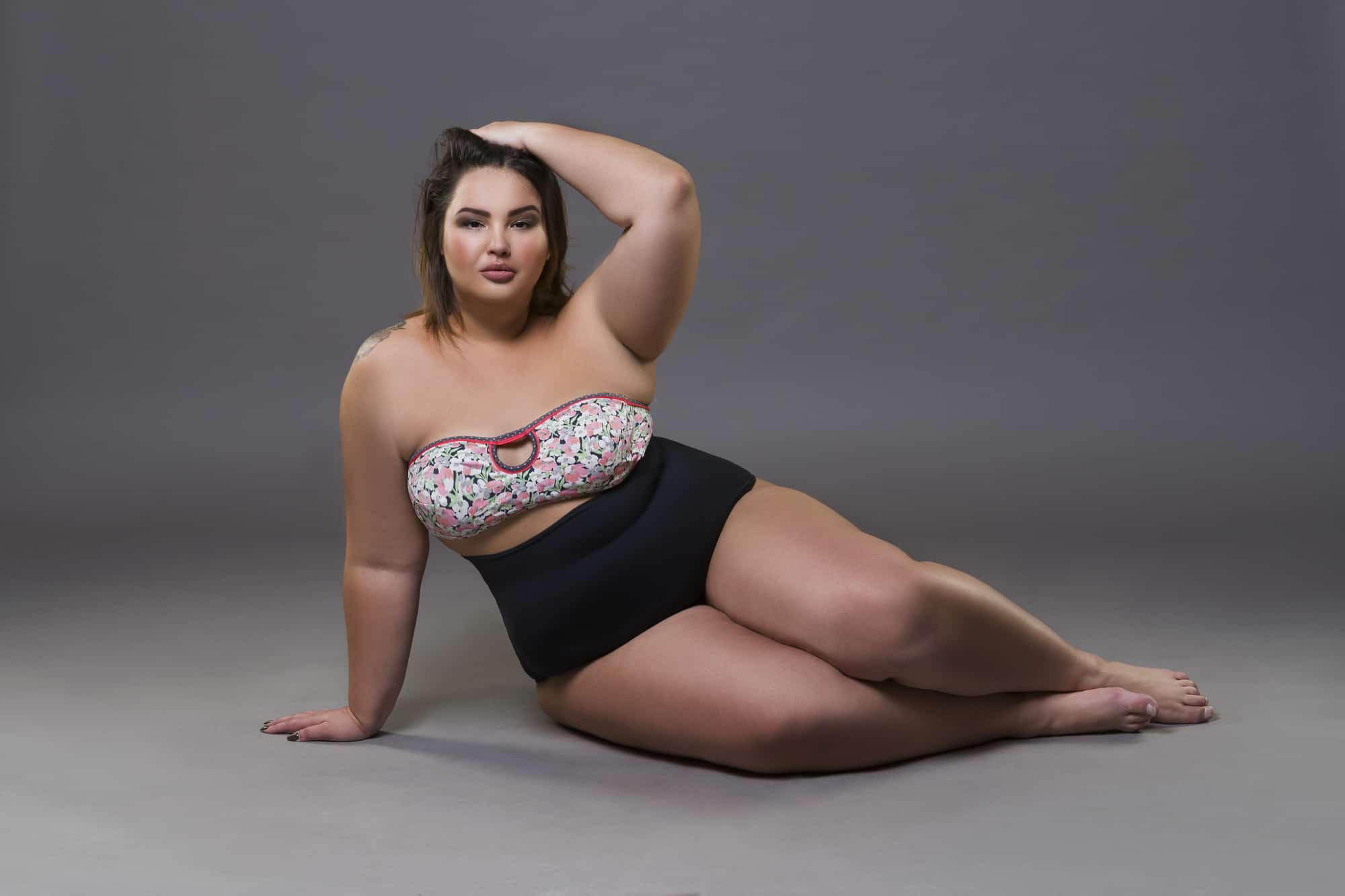Period underwear or period panties are super absorbent and a lifesaver for women when their period has come, but some of them could also be coated with persistent & hormone-disrupting Per- and polyfluoroalkyl substances (PFAS) chemicals. The Mamavation community members asked us to start testing “leak-proof” period underwear to see if it had any traces of PFAS so we did. And we have continued to test for over two years. So which period underwear is less likely to be made with a PFAS coating and better for your active lifestyle? You’ve trusted Mamavation to bring you topics like best non-toxic cookware, best air purifiers for the home, & best organic mattresses, now join us for the best & worst non-toxic period underwear with lab results showing that 65% of products tested could be contaminated with PFAS. Scroll down to the bottom if you want to see the raw data.
Disclosure: This post was medically reviewed by Hannah Gardener, Epidemiologist at Agreenslate.com. Donations were provided by Environmental Health News and Mamavation community members. Mamavation has only “spot-checked” the industry and thus we cannot make predictions about brands and products that we have not tested. Products and manufacturing aides can change without notice so buyer beware. This post contains affiliate links, with some to Amazon, which means Mamavation will receive a portion of those sales and we will use that to pay ourselves back for the testing. You can also give a tax-deductible donation to our consumer studies here through Environmental Health Sciences. Click “yes” when asked if the gift is in honor of someone and type “Mamavation.” Thank you!

Table of Contents
Period Underwear Could Be Exposing Consumers to Toxic PFAS
In early 2020, Jessian Choy, a journalist at Sierra Magazine (from the Sierra Club) shared results from the Laboratory of Applied Nuclear Physics at the University of Notre Dame regarding potential PFAS contamination in the most popular period underwear brand–Thinx.
We interviewed Jessian Choy and she told us that after years of wondering if this type of underwear contained a type of PFAS chemical, she decided to enlist the help of Dr. Graham Peaslee, a fellow at the American Chemical Society and professor of Applied Nuclear Physics. Dr. Graham Peaslee was also concerned with the potential outcome of PFAS in period underwear after releasing similar results about American food packaging. Peaslee has been researching PFAS for the past few years and was the scientist that discovered the presence of PFAS in fast-food wrappers in 2017. He’s also served as an ambassador for the newly debuted film starring Mark Ruffalo about PFAS called “Dark Waters,” in which he led a discussion about PFOA at Notre Dame University.
The results from these panties were shocking because they made it clear that products like period underwear could be manufactured with PFAS chemicals inside their “moisture-wicking” fabric and sold to unsuspecting American consumers. Since your period undies are right up against the vagina, it’s an important dermal exposure as it lies snug against the vulva for an extended period of time. Because scientists are already concerned about dermal exposure, it could be a very relevant avenue for toxic pollution into the body.
After Dr. Peaslee found fluorine in Thinx panties and it was covered by the Sierra Magazine, it was followed by Thinx denying any responsibility or possibility that it was true. Thinx then hired consultants (who were infamous for representing toxic chemical companies and thwarting regulation & public policy hard on toxic chemicals like perchlorate) to refute the findings of what Dr. Graham Peaslee found in his lab at the University of Notre Dame.
Shortly following the denial, Thinx changed the language on their website to allow them to sell Americans period panties with PFAS without getting into hot water. (We know because we checked.) Basically, any reference to the “PFAS” chemical category was removed, and instead, they replaced it with language that only claimed they were free from PFOA, which is one specific chemical within the class.
We also noticed other brands making similar changes in legal terms on their sites, but not all.
So in other words, the brands like Thinx haven’t changed their product, but they have changed the way they talk about their product. They aren’t telling you no PFAS chemical is present, they are instead telling you PFOA (one of the thousands of chemicals in that category) isn’t present. But obviously, there is more to worry about inside those panties than PFOA.
What about the other 12,000+ PFAS chemicals? Shouldn’t we know about those too? Mamavation reported on these findings in early 2020. Afterward, the community was very concerned about this product category and asked us to start testing different brands of period underwear to get a better understanding of which brands did not have any detectable fluorine. So this is exactly what we did starting in 2020 and you are reading the results of our privately commissioned study today. We have continuously added to this study with additional results as they are donated brand new in packaging to us by fans.

Why PFAS Chemicals Are Problematic Around Your Vagina
PFAS chemicals, otherwise known as per- and polyfluoroalkyl substances (PFAS), have been dubbed “forever chemicals” because of their staying power. These chemicals are extremely problematic to human health and the environment because they are persistent, meaning they build up and don’t go away. They resist degradation in the environment and they remain in our bodies for YEARS after exposure, sometimes decades.
“The fact that this is a preventable exposure that accumulates in the body, and young child-bearing-age women are being exposed has impacts not only for those who use this underwear, but also potentially for their future children because these compounds stay in our bodies for years!” says Hannah Gardener, founding epidemiologist at Agreenslate.com and Advisor to Mamavation. “These underwear with ‘forever chemicals’ have environmental implications from production to being washed in our washing machines all the way to the end of their life cycle in landfills.”
Researchers are also very concerned about dermal contact of PFAS and are worried that the health outcomes may be similar to ingestion. Therefore, it’s important to avoid PFAS as much as possible around the vaginal area and any other area because it builds up in the body.
In other words, they are not quickly excreted from our bodies like other hormone-disrupting environmental contaminants. And that staying power has become a very big deal in food packaging, water…and now fabrics.
I highly recommend watching Dark Waters, a true story about PFAS chemicals contaminating small-town America starring Mark Ruffalo, Anne Hathaway, and Tim Robbins. This short trailer will give you a quick understanding of what is happening around the United States to our water supply. And it’s quite serious.
Potential Health Effects of PFAS Chemicals from Research
PFAS (aka PFCs or perfluorinated chemicals, including PFOA and PFOS) are added to many products we purchase to make them “stain-resistant,” “grease-proof,” and “water-resistant.” In food packaging, they are used in popcorn bags, pizza boxes, fast food canisters & wrappers, and the flat dish on the bottom of cakes. They are also in carpeting, furniture, & clothing as “stain-proof” agents. You can also find them on non-stick pans, some tooth flosses, and cosmetics.
Here is the list of health problems (PFAS) perfluorinated chemicals are linked with.
- Reduction in immunity
- Reduced vaccination response
- Increased risk of allergies & asthma in young children
- Affected growth, learning, and behavior of infants and older children
- Increase cholesterol levels
- Metabolic diseases like obesity & diabetes
- Cardiovascular disease
- Lowered a woman’s chance of getting pregnant
- Lowered male fertility
- Increased risk of kidney & testicular cancers
- Causes endocrine disruption
- Disrupted normal thyroid function
“These results add to the growing body of evidence reaffirming that we need to know more, not less, about the ingredients in period products. Millions use menstrual products monthly. It is unacceptable that there are so many unknowns about the ingredients, safety, and health impacts of products that come into contact with one of the most sensitive and absorbent parts of the body,” said Alexandra Scranton, Director of Science and Research at Women’s Voices for the Earth (WVE), a national environmental health organization, that has been advocating for ingredient transparency and safety of period care products for the last decade. “Furthermore this new testing also shows that PFAS-free period underwear is possible. Which means, not only are these chemicals adding potentially harmful exposure to our bodies and the environment, but they are also unnecessary to the performance and efficacy of these products.”
If you feel like you’ve been exposed to PFAS, the Agency for Toxic Substances and Disease Registry, a division of Community Health Investigations has created this fact sheet to use when talking to your doctor.

Why Are Brands Claiming They Are PFAS Free When They Are Not? Overstating OEKO-TEX® Certification Was One Issue.
We noticed that some brands were making claims of being PFAS-free because they use OEKO-TEX® certified fabrics and were under the impression that OEKO-TEX® means “PFAS-free.” We found this assumption NOT to be true. After discovering examples of OEKO-TEX® certified period panty fabrics testing for high levels of fluorine, Mamavation decided to investigate further.
We interviewed Ben Mead, Managing Director of Hohenstein Institute America, which is a company that manages the OEKO-TEX® standard in the United States. Ben made it clear to us in an interview over the phone that OEKO-TEX® tests for only 30+ the most common PFAS chemicals directly like PFOA and they do not test their fabrics for fluorine at all.
Because OEKO-TEX® does not test their approved chemicals for fluorine, we cannot be sure they do not contain any of the other thousands of PFAS chemicals they are not testing for.
It’s like a “test no evil see no evil” type of situation.
OEKO-TEX® has added some additional “PFOA-like” chemicals to their testing in 2021, but we are still not convinced they are looking for every possible PFAS chemical, especially the “short-chain” ones. Therefore any brand that is relying on OEKO-TEX® to make that claim, may actually be in for a big surprise. Sadly, It’s not fool-proof as you’ll see in the results we got.
As we were interviewing brands about this topic, it was clear to us that most of them were not even aware you could test for fluorine as a way to spot “short-chain” PFAS chemicals in their panties.
The only industry excelling at testing for fluorine instead of each PFAS chemical individually is the composting & food packaging industry. Period underwear companies need to catch up.

Mamavation’s Scientific Advisor Pete Myers Explains Why Current Federal Testing Requirements Are Not Enough To Protect Families
Pete Myers, our main scientific advisor, gave us an interview about what the problems are in terms of how chemicals are evaluated at the Federal level and how that leaves HUGE gaps of concerns for families, particularly women & children.
Pete Myers reviewed three problems that exist that can be adjusted to make pregnant women and families safer. Most of the problems are around how the chemicals are tested and regulated.

Low Dose Testing of Chemicals Isn’t Required By Feds & It Should Be
You know that saying “dose equals the poison?” It’s the idea that chemicals are only dangerous at various doses inside your body. High doses may cause death so they are typically avoided, but what if low doses could also cause damage over time?
First, the Feds assumed that high dose testing will tell them everything they need to know about low dose testing without doing the low dose testing. According to Pete, they do the high dose testing and then extrapolate what they think will happen at low doses. However, nothing is actually done to look at these low doses.
While that works with some poisons according to Pete, it emphatically doesn’t for endocrine-disrupting compounds. And that’s because different genes get turned on and off at different parts of the dose-response curve. What happens at low doses can be just the opposite of what happens at high doses. And because of the way they structure their tests, they never dose at the low levels that are relevant to most people’s experience.
In other words, they really have no idea what will actually happen. They are guessing.
Pete has written multiple scientific (and peer-reviewed) papers on this. You can find two of them here and . And when he published the second one the country’s top toxicologist, Dr. Linda Birnbaum, former director of the National Institute of Environmental Health Sciences wrote an editorial concluding that this should be the general expectation for endocrine-disrupting compounds.
Should low-dose testing be considered? I guess it depends on what your interpretation of “safe” is. If you don’t want to know, don’t test. If you don’t test low doses, you definitely won’t understand their impacts.

Only the Active Ingredient is Analyzed to Determine Safety Leaving Out Real-World Exposures
Second according to Pete, when the Feds test pesticides, they only test the active ingredient. They aren’t looking at our real-world exposure of a complete formulation, just certain ingredients inside. And that is also completely absurd. It’s like testing the tomatoes in a spaghetti sauce but missing the oils, herbs, and other ingredients.
Refusing to test the entire formulation means they don’t know how it’s reacting with your body as it’s sold or applied. The actual product contains a complex mixture of other chemicals that are included specifically to make the active ingredient more toxic. And it’s not just pesticides that have this problem. We live in a soup of nasties that can interact in ways that dramatically make the mixture more dangerous than just one chemical. Is this toxic soup safe? I guess it depends on what your interpretation of “safe” is. If you don’t want to know, don’t test the products the way families experience them in their homes.

The Feds Use Antiquated Testing Instead of Modern Testing to Evaluate Modern Chemicals
Third according to Pete, the tests they use are way out of date. The Feds rely on antiquated testing compared to the tools that independent scientists use when examining toxicity.
Here’s Pete’s analogy–”Imagine you’re an FDA employee and you’ve just seen photographs in National Geographic of distant galaxies taken by the Hubble Space Telescope. You’ve never seen anything like it. So what do you do? You grab your binoculars and go into your backyard at night, look up toward the stars, and see nothing like those photographs. You don’t see anything so you conclude the photographs are FAKE NEWS.
One of the crude tests the EPA and FDA use was actually developed in the 1930s. In case they didn’t know, medical science has advanced a lot since 1935. Their tests are totally insensitive to what we need to know about endocrine-disrupting chemicals. To determine what is “safe” you need to use modern medical tools. Not surprisingly, they aren’t finding anything, so they are able to say “no danger here!” But does that mean they are right? I guess this depends on what your interpretation of “safe” is.
Mamavation’s Investigation of Period Panties & Period Underwear
Mamavation tested the most popular period panties (some up to 4x) looking for fluorine, the chemical that unites all PFAS chemicals. This is important to understand–because there are thousands of PFAS chemicals in commerce and most are not even possible to find because we do not have the tests available, we are testing for fluorine instead. This is exactly what the food packaging industry does to determine whether PFAS was “intentionally added” and can be composted or not. So this standard already exists in other industries and within different state laws formulated around packaging and PFAS and can be a valuable tool to period underwear companies when testing their own products for PFAS.
Because testing for fluorine is the only standard that is out there, we’ve adapted this to fabrics and are using it for this investigation on period underwear. BPI Industries uses the standard of 100 ppm of fluorine to determine if PFAS was intentionally added, so we’ve done the same.
Brands with over 100 ppm of fluorine go into the “not our favorite” category, while brands that test between 0-100 ppm will be in the “better” category, and brands that don’t have any fluorine residue will be in the “best” category.
Results From Mamavation’s Study on Period Panties
[UPDATED WITH ADDITIONAL PRODUCT SINCE ORIGINAL STUDY POSTED. Mamavation has accepted donations of brand new period underwear products and has continued to update this recommended list. August 16, 2021: Mamavation added additional results from 2 period underwear brands bringing the total up to 19 period underwear products tested. UPDATED October 15th, 2021: Mamavation added 1 additional brand bringing total to 20 brands. Those new brands are marked with a *. UPDATED June 15th, 2022 Mamavation added 1 additional brand bringing the total to 21. UPDATED June 23rd, 2022 Mamavation added additional brands.]
ORIGINAL STUDY MAY 24, 2021: Mamavation sent 17 pairs of period underwear from 14 brands to an EPA-certified laboratory that used the determination of total fluorine by oxygen flask combustion and ion-selective electrode analysis. The level of qualification (LOQ) was 10 parts per million. We did not test panty liners, tampons, menstrual cups, period swimwear or regular underwear. We tested a bikini, briefs, waist bikini, high-waist, boxer briefs, & super hiphugger period underwear advertised to accommodate heavier flow days in sizes from XS to XXL. Here are the major findings from our laboratory:
- About 65% of the products tested had detectable levels of fluorine present in either the outer or inner layer of the crotch. Of the 17 pairs of period underwear tested, 11 pairs had detectable fluorine present.
- 35% of the products tested did NOT have detectable levels of fluorine present in either the outer or inner layer of the crotch. Of the 17 pairs of period underwear tested, 6 products did not contain detectable levels of fluorine.
- 57% of period underwear brands tested had detectable levels of fluorine present in either the outer or inner layer of the crotch. Of the 14 period underwear brands tested, 8 brands had detectable levels of fluorine present.
- 3 brands of period underwear had levels of fluorine over 100 ppm, with one as high as 940 ppm.
- 2 brands of period underwear had products with various levels of fluorine detected so they are found in different levels of the investigation.
- 7 brands of period underwear had products with lower levels of fluorine present suggesting they may have been exposed unintentionally from processing or from the packaging.
- 6 brands of period underwear out of 14 brands were completely free of detectable fluorine, suggesting PFAS chemicals are not needed in period underwear at all. (Today that number is higher!)

Not Our Favorite Period Underwear Brands
These brands tested at over 100 ppm of fluorine. We tested several types of brands and retested different types of underwear for some brands that ended up here. The 100ppm standard is the same standard used to determine if food packaging is compostable. It’s not a perfect standard, but this is what we have. However, we make no claims as to how much fluorine is dangerous vs. safe for dermal exposure in your vaginal area. We simply do not know.
- Thinx Bayshort–619 ppm fluorine
- Thinx High Waist–940 ppm fluorine
- Thinx BTWN–132 ppm fluorine
- Knix High Rise–373 ppm fluorine
- Proof Hipster–234 ppm fluorine
Better Period Underwear Brands
Fluorine was found but under 100 ppm. That specific level is the same standard to determine whether food packaging is compostable, so we are using it here for similar purposes. However, we make no claims as to how much fluorine is dangerous vs. safe. We simply do not know.
- Cora–14ppm & 13ppm organic fluorine* (new brand added)
- Knix Boyshorts–43 ppm fluorine
- Knix High Waisted Period Underwear–17 ppm fluorine (new results added)
- Joyja–18 ppm fluorine
- Maxim Hygiene–26 ppm organic fluorine (new brand added)
- Panty’s— 37 ppm organic fluorine (new brand added)
- RAEL Period Underwear— 15 ppm organic fluorine & 10 ppm organic fluorine (Update: 4/27/23)
- Red Ruby Box–27 ppm & 22 ppm fluorine
- Sustain Natural–71 ppm & 17 ppm fluorine
- Thinx Speak High Waist–10 ppm fluorine
- Victoria’s Secret–20 ppm & 12 ppm fluorine
Best Period Underwear Brands
Mamavation used an EPA-certified lab to do this testing. No fluorine was detected in any of these products sent to the lab in 2020 and 2021. The Level of Qualification (LOQ) for testing was 10 parts per million, therefore if products had fluorine at lower levels, the test would not find it. We cannot guarantee these brands will continue to test the same. This was only a snapshot in time to help guide you in purchases. Most brands are using a thin layer of polyester or nylon to capture up to 5 tampons’ worth of heavy flow and keep it in your panties.
- Lilova (no fluorine detected)(*newest brand added) Use discount code “MAMAVATION15” for 15% off your order.
- Aisle (formerly known as Lunapads) (no fluorine detected) Use discount code “MAMAVATION” for $10 off any order over $35
- Bali Women’s Beautifully Confident Light Leak & Period Underwear (no fluorine detected –testing in 2023)
- Bambody (no fluorine detected testing in 2021)(additional testing in 2023 was non-detect for organic fluorine)
- Innersy Big Girls Period Underwear — non-detect organic fluorine testing update 6-23-23
- Intimate Portal (no fluorine detected)
- June Period Underwear (no organic fluorine detected) (Updated: 4/27/23)
- Period (no fluorine detected) Use discount code “MAMA” for a special sale of “Buy 3 panties and get 1 free”
- Modibodi (no fluorine detected) Use discount code “MAMA10” for 10% off orders over $100 for new customers. Not to be used in conjunction with any other offer, on sale, gift cards or bundle packs. Limit one per customer.
- (no fluorine detected) Use discount code “MAMAVATION” for 15% off your first purchase.
- Saalt Period Underwear— non-detect organic fluorine result 2023. (Prior testing in 2021 had a detection of 10 ppm fluorine. Kudos to Saalt for fixing this issue!) Use discount code “MAMAVATION” for 15 % off your first purchase. One use per customer, excluding bundles.
Conclusion of Mamavation’s Period Underwear Investigation
Mamavation hopes that this investigation will be useful in giving consumers an idea of what is inside period underwear and give regulators a clearer picture of what is happening in this industry right now. We also hope this investigation will be used by regulatory bodies to ascertain the potential risks to anyone wearing period underwear.
This investigation was independently funded by Mamavation. We also wanted to remind you that above you will find affiliate links that will be used to reimburse our costs. If you have found this investigation useful, we encourage you to browse the site to find other investigations like cookware, organic mattresses, air purifiers, or probiotics to name some of our most popular.
And if you would like to join our supportive community for women, where you can have some say in what products we look into, you can click to apply here.






 Report Alerts Consumers to Greenwashing in Baby Crib Mattress Industry
Report Alerts Consumers to Greenwashing in Baby Crib Mattress Industry
Hi! Would love for you to test “Proof” period underwear and brand “Mme L’Ovary” for PFAS. Thank you 🙂
Hi! Is it possible to test WUKA period underwear? Thank you
What about Mool? https://www.moolunderwear.com/
I would like to know this too as someone who owns mool underwear!
Hi! I have a question. Was Revol tested again in 2023 for PFAS? If not, is a retest possible? Thank you!
Would love to see LoveLuna added if you have the chance!
Will you consider testing Hanes Please? They’re the least expensive I’ve found so more affordable & more accessible for people with less money. They’re one of the only co.s I know of with cotton options & with solid coverage too. Thank you for all the info!!!
Thank for the article ! Very helpful. i second this since these are affordable , i use them for my teen daughter.
I’m curious what the test results would be if these were washed once. Testing after laundering makes sense to me because we launder them before we wear them (or at least before we wear them a second time!) so that result seems like it would capture the most relevant information. Are you considering testing the undies after a wash? I’d love to see the results.
The Revol and Lilova sites don’t work, whether I use the links in this article or Google them and go on my own. They time out.
I’d love an update on this article since it’s been a couple of years!
Would Speax incontinence panties have PFAS in them as they are under the Think company, have Speax been tested at all? Is it assumable that it does have PFAS?
Target sells a brand called Unders. I wonder about those. I’ve used them and they work well as leak protection while using a cup. I have Joyja as well but they’ll leak.
Hi I recently found your blog and it’s been super helpful. I was wondering which specific period underwear ‘type'(s) you tested for the ones that are rated best? I want to make sure the ones I get are not contaminated. Thank you!
Another brand I own is Neione… If you plan to test other brands, please take a look at that one… I got them on Amazon.
I also got Neione since Thinx were so expensive, would also like to know.
I second this. I have been wearing these ever since I bought them.
Thank you so much for publishing this study. Would you be able to test for period swimwear as well? The brands I have followed include: Modibodi, Knix/Knix Teen and Ruby Love, among others. My daughter is a young swimmer who cannot tolerate tampons. We have to give her period swimwear and I wonder about PFAS in all swimwear out there on the market!
Seconding the request for testing of period swimwear. For young girls who swim competitively (or just for fun) and can’t wear tampons, their only choice is period swim wear.
second this request for my daughter
Hi, I’m wondering why A) your testing wasn’t size inclusive [as many of these brands go up to 6XL), B) why the style’s of unfavorable panties are listed but why the styles of “Excellent” panties are not listed and C) If you can share the lab reports of these findings. Thank you!
Thanks for this study. Would you be able to add Innersy to your list of brands to check out next time you do testing? Thanks for considering!
Second this! Thank you!
third this request for Innersy please.
I fourth this request for Innersy.
I fourth the request for Innersy.
Hi! Thanks so much for all this important and amazing work! Would you be able to test out Aerie period underwear products? They’ve been on sale quite frequently recently and I know of lots of students/people on budgets giving them a try because of that – would be really grateful in seeing them tested
I’d like to know if Bali is safe?
There is a new brand of period underwear that are ultra thin and super absorbent called PURE ROSY. Unlike most period underwear, they are a fashion product with patented absorbing technology and leakproof protection in many types of absorbency and are seamless under your clothing.
Go to the site:
http://www.purerosy.com
Can you check if Hannah period products is PFAS free?
Interesting article. Since it’s been a year since this study and there are so many new brands on the market it would be great to see an update. Have any of these companies improved their product since your findings? Does The Period Company actually live up to their ‘zero toxins’ claims? Thanks!
Was the Hanes girls period underwear tested for PFAs? I just bought some.
Thank you so much for conducting this testing and publishing the results! I ordered several pairs from Proof before becoming aware of this issue. I spent weeks trying to get a clear answer from them, and they finally assured me via email that they test their products via a third party laboratory. However, they didn’t say what specific tests were conducted, and getting a clear answer has been like pulling teeth. I’m not sure if I should keep requesting more information or just return everything.
Hi,
Thanks for doing all this and updating. I’m curious what does, “non-detect organic Floride mean”?
Hi,
Thank you for this important work!! So grateful.. Also have you plans to test TomboyX?
thank you
Send me a new one unopened in packaging and I can
Did anyone ever send you a pair of TomboyX?
No but if you want to donate a brand new pair for us to study, we can accept it. Email me at leah at mamavation dot com and include “DONATION” in the title please.
Thanks to all your hard work, my daughter’s firs period was in panties from the best list. I can’t go back and change what I did, but I can certainly protect her thanks to all your hard work Leah!! xoxo
You’re welcome! XXOO
What about Dear Kate period underwear?
Duly noted. We can test that sometime soon.
Yes, would love to have Dear Kates tested. Their website claims: DOES YOUR LINING CONTAIN PFAS?
No. The tech we use in our garments is proprietary and was designed and developed to be safe and effective. We use our lining materials in a double layer with the top layer coming into direct contact with the body. These materials do NOT contain PFAS (per- or polyfluoroalykl substances) and they are compliant with Proposition 65, REACH, RoHS 2 and RoHS 3; PFOA, PFOS, Phalate, DMF, BPA and APEO free. We have used the same materials since day one, sourced through a company that has been named to the World’s Most Ethical Companies by the Ethisphere Institute. In everything we do, we will continue to uphold our commitment to quality, consistency and safety, providing customers the most up-to-date information.
Is the testing done on unwashed undies? If so do the forever chemicals get washed away after the first wash? I have 3 of these and have used them many time I wonder if they’re now “clean” after 10 or so washes?
Sad to see victoria secret has them, but not surprised. 😕
Thank you for this important research. I’m super disappointed in Thinx. I emailed them before purchasing to ask about chemicals and toxins and was told they had NONE in them! I’ve now emailed the company back with a screenshot of that email reply and asking for a full refund for the almost $500 that I’ve spent on their underwear, since they lied to me about what was in them.
Did you ever get a response from Thinx? I purchased some for my daughter too back in May 2022 when she started her period and she’s been wearing them for the 9 months she’s had her period but no longer until I get a response too. I emailed them this morning and although it said they’d get back in an hour, I still haven’t heard back and somehow doubt I will. Thinx are also are on sale at Walmart now. Very displeased. I loved their product.
Thank you for this! I have period issues anyway and had a small panic attack as I was reading. I use Bambody underwear. Was glad to see it showed no florine!
I am so glad I stumbled on this article. I have been buying Thinx but I’ll be switching now that I am aware of the Flourine issue!
Is Knix period underwear safe now? They say that they started testing for Fluorine in January 2020 and they show reports that show no Fluorine. I am confused, because the tests on here show high levels of Fluorine for this brand. Did they change their product, or are Knix’s tests inaccurate? When were your tests showing that Knix contains high levels of Fluorine conducted? https://knix.com/blogs/knix-blog/yes-knix-underwear-are-toxic-chemical-free
Regarding Modibodi, did you test their vegan line or only the ones with wool in them?
I’m just starting to shop for period undies and wonder about the polyester liner. We only wear organic cotton undies to avoid glyphosate, etc. Is the liner not an issue? Thanks!
What about disposable incontinence products? Blessings, Karen
What about Padkix?
We can add that brand to the list of what will be tested in the near future. We will have an update with another two brands soon.
Can you also test Rael, they claim no PFAS but I’m wondering if that’s cleverly worded to mean in the cotton and not in the liner. I would like to know if they are 100% free or only part of them is free of these.
Can you post a copy of the lab results? I know you listed the results, but I’d like to see the actual white paper. Thanks!
Are there any of these TOXINS in pads & liners?
Hey lovely.
Yes pads and liners are full of chemicals. Ensure to use only organic products in contact with your vagina. Most organic brands will label their ingredients xx
I haven’t tested any pads or liners yet. Perhaps soon! This one was really expensive though so give me a breather for a bit, mkay?
If you do get around to testing pads, I’d love to see an analysis of cloth pads like Party in My Pants.
Very helpful information, good work.
What other products from those companies? Should it be assumed all Thinx products would have similar results?
We don’t know. That’s the honest truth.
Hi Leah – Thank you for all that you do and bringing this to light. I think it would be interesting – and important- to test the Speax line by Thinx as that is underwear that many women wear every day, hence higher frequency of exposure.
i agree. that link is an affiliate link and the author/website should be transparent in the fact that the site gets a commission from an audience’s purchases through that link or using the discount code.
I agree. I hovered over the link and saw that “affiliate” was in it, meaning that there is a commission involved in the brand recommendation. Not saying the brand can’t be good, but full transparency that the site/author gets a monetary benefit from the audience’s purchases through that link and using the code is necessary.
Very nice study and thorough explanation. Well done. This is invaluable information for consumers.
I need to know if the liners are suitable for a weak bladder to catch leaks ?
What about FLux underwear?
a very detailed and specific article that left me with no questions
You Modibodi link above doesn’t work modibodi.com
I highly recommend Modibodi, a woman-owned company doing everything possible to treat the environment well. Modibodi offers tons of options including great products for tweens and incontinence products for men. The content of your article is good, I just disagree with your conclusion that Aisle is best. How nice they offered you a discount though!
Do you work for this company?
The company names are listed alphabetically.
The company names are listed alphabetically.
It would be awesome if period aisle made panties for tweens.
I am buying some for my 12 year old. I bought a size small for me and they fit her too. She is 95 lbs and 5’3″ so she is very thin. I think they also sell xs.
Hi! The Period Company makes amazing ones! http://Www.period.co
I know Bc I’m a mom and the founder! Zero Toxins. Period.
I love you’re company. The underwear I purchased there has been life-improving by so much. I cannot overstate it! I also enjoy the communications I get (this might sound silly to other readers) but they are really thoughtful and empowering- I actually READ them. Lastly, the customer service has been great. There was a delay once (bc so many people seem to love your Irish r( and your company sent me multiple updates and gave me an additional pair when they were back in stock. I know this was not the point of this study but I felt the need to share my admiration publicly 🙂
Have you tested Rael underwear?
Hi! Will you please consider testing Lola period undies?
If you send me a new pair, I’d be more than happy to.
Maybe I’m missing it, but did you test Always ZZZ period underwear?
If not, I can send you a new box.
Where can this be verified? I’m really interested in the Period Co but (don’t take this the wrong way) am somewhat sketched out by the low prices.